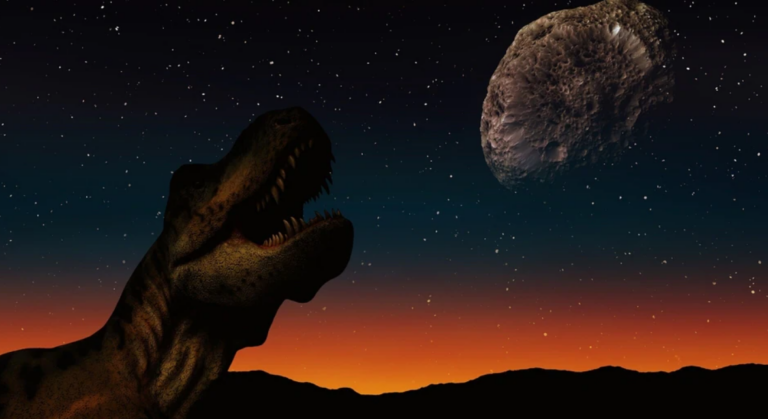Study Reveals Dinosaur-Killing Asteroid Originated from the Outer Solar System
A new piece of research that took place in Japan has found the location of the asteroid that lead to the killing of dinosaurs as being beyond Jupiter, a discovery that goes against previous theories.
Combining a modern latest knowledge in the isotopic analysis, scientists concluded that the Chicxulub impactor, which hit our planet 66 million years ago, probably originated from the part of the space rich in carbon thus proving it indeed was an asteroid and not a comet as some theorized earlier.
Traveling at 15. at a quite unbearable speed of 5 miles per second this asteroid which was at least 5 kilometers in diameter created a crater of 90 miles and liberated energy that was equivalent to 10,000 nuclear arsenals leading to the extinction of about 80% of animals.
About sixty-six million years ago, a giant asteroid put its foot on the neck of our planet and by so doing initiated a widespread extinction of all non-avian dinosaurs. Now researchers think they know the source of this devastating space rock.
In addition, a study of the metal isotopes released by impact indicates that the asteroid originated outside of Jupiter’s orbit. The researchers also looked at five other asteroid impacts and concluded that the latter belongs to the inner planar asteroids.
In an interview as cited in Scientific American with Lee Billings, Steve Desch an astrophysicist from Arizona State University supports these result, saying they are very convincing to him. “They are well in sync with other existing evidence”
David Kring, a scientist at the Lunar and Planetary Institute, was the first to associate the impact crater with the mass extinction event and said about the paper to Live Science’s Sharmila Kuthunur: “The paper provides a very nice set of isotope studies The origin of such objects and their identification must be discussed to assess future risks.
There have been five mass extinctions in the history of the earth with one being around 250 million years ago which is referred to as the Great Dying almost wiped out all life on earth. The last mass extinction is the one that lead to the extinction of dinosaurs on the Earth.
The asteroid that caused it is said to have been between 6 and 12 miles wide before the impact and is known as the Chicxulub impactor. Although the meteor was highly thought to be moving at a very high speed, it caused an explosion that formed a crater which is over 90miles in size. They went as fast as it might according to NASA at a speed of 15. five miles per second and released power, in the form of heat, ten-thousand times the explosives power of the world’s nuclear arsenal. The asteroid impacted on the Yucatán Peninsula yielding today’s Chicxulub crater in Mexico.
It is well known to have completely wiped out about ninety per cent of all the animal genera then existing on the earth. The impact skidded out dense and thick soot and vapor to the atmosphere causing darkness and resulting to a global extinction.
“This impact altered our planet’s environment in its entirety for the worst and created conditions suitable for mammalian evolution”, says Mario Fischer Gödde, the author of the study and a geochemist in the University of Cologne in Germany in an interview with the Scientific American.
The effect also spread metals that fell in different parts of the kingdom and is now locked in a layer of rock commemorating the day. This layer lies between the Cretaceous and Paleogene period and is therefore referred to as the K/Pg boundary.
One of these metals is ruthenium which is actually very scarce in the Earth’s crust but quite often found in meteorites. Detection of the amount of ruthenium isotopes in an asteroid depends on the space it has come from. To understand the source of Chicxulub asteroid, the research team measured the abundance of ruthenium’s seven isotopes at K/Pg boundary.
“Thus, the present study was developed from the hypothesis that, since there are differences in the isotope ratios of ruthenium in different kinds of meteorites and that elements such as ruthenium are concentration-dependent in the boundary layer and come from extra-terrestrial objects, the isotope ratio data of the boundary layer would provide information on the nature of the impacter,” explains Fischer-Gödde to National Geographic’s Riley Black.
Researchers took samples from ten different sections of K/Pg boundary and five other areas related to impact theories. Thus, the researchers established that the boundary samples contain the isotopes of ruthenium comparable to that of the carbonaceous meteorites which can be associated with the outer solar system and therefore the Chicxulub asteroid. The other impacts in the ORDER sites were closer to the chondrites from the inner solar system which have more silicate components.
“The paper’s interpretation isn’t new,” says Richard J. Walker, a geochemist with the University of Maryland who did not participate in the study, to Scientific American. However, much stronger evidence to support the theory that Chicxulub impactor was a carbonaceous asteroid is offered by this study.
The study also disproves the suggestion that the impactor could have been a comet, as had been proposed by some experts in the past. This strengthens the argument that the strike originated from an asteroid, and ‘does an excellent job of strengthening that conclusion’, according to a geophysicist of the University of Texas at Austin, not involved in the study, Marshall of Nature News.
Do not forget to share your opinion with us to provide you with the best posts !




0 Comments